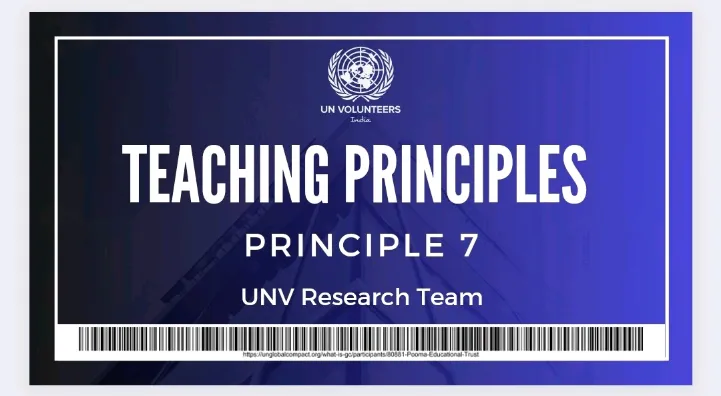Teaching principle 7
Teaching principles
PRINCIPLE 7
Students' self-regulation assists learning, and self-regulatory skills can be taught.
Explanation
Self-regulation in learning refers to students' ability to understand and control their learning processes. It's about being aware of their learning goals, the strategies they use to learn, and their ability to monitor and adjust those strategies for optimal learning outcomes.
For example, let's consider a student learning algebra who is aware that they struggle with quadratic equations. A self-regulated learner might:
1. Set a specific goal to improve in this area (e.g., "I want to solve quadratic equations without errors").
2. Plan and apply strategies to achieve this goal (e.g., practicing problems, seeking help from a teacher, or using educational resources).
3. Monitor their progress (e.g., keeping track of the number of correct solutions).
4. Adjust their strategies if progress is not as expected (e.g., trying a different problem-solving approach or seeking additional resources).
By teaching students how to set goals, plan, monitor, and adjust, educators can help them become more effective learners. This process not only aids in the current learning task but also equips students with skills that can be applied to future learning challenges, fostering lifelong learning habits.
கற்பித்தல் கொள்கைகள்
கொள்கை 7
மாணவர்களின் சுய கட்டுப்பாடு கற்றலுக்கு உதவுகிறது மற்றும் சுய ஒழுங்குமுறை திறன்களை கற்பிக்க முடியும்.
விளக்கம்
கற்றலில் சுய கட்டுப்பாடு என்பது மாணவர்களின் கற்றல் செயல்முறைகளைப் புரிந்துகொண்டு கட்டுப்படுத்தும் திறனைக் குறிக்கிறது. இது அவர்களின் கற்றல் இலக்குகள், கற்க அவர்கள் பயன்படுத்தும் உத்திகள் மற்றும் உகந்த கற்றல் விளைவுகளுக்காக அந்த உத்திகளைக் கண்காணித்து சரிசெய்வதற்கான அவர்களின் திறனைப் பற்றி அறிந்திருப்பது பற்றியது.
எடுத்துக்காட்டாக, இருபடிச் சமன்பாடுகளுடன் போராடுவதை அறிந்த ஒரு மாணவர் இயற்கணிதத்தைக் கற்பதைக் கருத்தில் கொள்வோம்.
சுய-ஒழுங்குபடுத்தப்பட்ட கற்றவர்:
1. இந்த பகுதியில் மேம்படுத்த ஒரு குறிப்பிட்ட இலக்கை அமைக்கவும் (எ.கா., "நான் பிழைகள் இல்லாமல் இருபடி சமன்பாடுகளை தீர்க்க விரும்புகிறேன்").
2. இந்த இலக்கை அடைவதற்கான உத்திகளைத் திட்டமிட்டுப் பயன்படுத்துங்கள் (எ.கா., பிரச்சனைகளைப் பயிற்சி செய்தல், ஆசிரியரிடம் உதவி பெறுதல் அல்லது கல்வி ஆதாரங்களைப் பயன்படுத்துதல்).
3. அவர்களின் முன்னேற்றத்தைக் கண்காணிக்கவும் (எ.கா., சரியான தீர்வுகளின் எண்ணிக்கையைக் கண்காணிப்பது).
4. எதிர்பார்த்தபடி முன்னேற்றம் இல்லாவிட்டால் அவர்களின் உத்திகளைச் சரிசெய்யவும் (எ.கா., வேறு சிக்கலைத் தீர்க்கும் அணுகுமுறையை முயற்சிப்பது அல்லது கூடுதல் ஆதாரங்களைத் தேடுவது).
இலக்குகளை நிர்ணயிப்பது, திட்டமிடுவது, கண்காணிப்பது மற்றும் சரிசெய்வது எப்படி என்பதை மாணவர்களுக்குக் கற்பிப்பதன் மூலம், கல்வியாளர்கள் அவர்களை மிகவும் பயனுள்ள கற்றவர்களாக மாற்ற உதவலாம். இந்த செயல்முறை தற்போதைய கற்றல் பணிக்கு உதவுவது மட்டுமல்லாமல், எதிர்கால கற்றல் சவால்களுக்கு பயன்படுத்தக்கூடிய திறன்களுடன் மாணவர்களை சித்தப்படுத்துகிறது, வாழ்நாள் முழுவதும் கற்றல் பழக்கத்தை வளர்க்கிறது.
PRINCIPLE 7
Students' self-regulation assists learning, and self-regulatory skills can be taught.
Explanation
Self-regulation in learning refers to students' ability to understand and control their learning processes. It's about being aware of their learning goals, the strategies they use to learn, and their ability to monitor and adjust those strategies for optimal learning outcomes.
For example, let's consider a student learning algebra who is aware that they struggle with quadratic equations. A self-regulated learner might:
1. Set a specific goal to improve in this area (e.g., "I want to solve quadratic equations without errors").
2. Plan and apply strategies to achieve this goal (e.g., practicing problems, seeking help from a teacher, or using educational resources).
3. Monitor their progress (e.g., keeping track of the number of correct solutions).
4. Adjust their strategies if progress is not as expected (e.g., trying a different problem-solving approach or seeking additional resources).
By teaching students how to set goals, plan, monitor, and adjust, educators can help them become more effective learners. This process not only aids in the current learning task but also equips students with skills that can be applied to future learning challenges, fostering lifelong learning habits.
கற்பித்தல் கொள்கைகள்
கொள்கை 7
மாணவர்களின் சுய கட்டுப்பாடு கற்றலுக்கு உதவுகிறது மற்றும் சுய ஒழுங்குமுறை திறன்களை கற்பிக்க முடியும்.
விளக்கம்
கற்றலில் சுய கட்டுப்பாடு என்பது மாணவர்களின் கற்றல் செயல்முறைகளைப் புரிந்துகொண்டு கட்டுப்படுத்தும் திறனைக் குறிக்கிறது. இது அவர்களின் கற்றல் இலக்குகள், கற்க அவர்கள் பயன்படுத்தும் உத்திகள் மற்றும் உகந்த கற்றல் விளைவுகளுக்காக அந்த உத்திகளைக் கண்காணித்து சரிசெய்வதற்கான அவர்களின் திறனைப் பற்றி அறிந்திருப்பது பற்றியது.
எடுத்துக்காட்டாக, இருபடிச் சமன்பாடுகளுடன் போராடுவதை அறிந்த ஒரு மாணவர் இயற்கணிதத்தைக் கற்பதைக் கருத்தில் கொள்வோம்.
சுய-ஒழுங்குபடுத்தப்பட்ட கற்றவர்:
1. இந்த பகுதியில் மேம்படுத்த ஒரு குறிப்பிட்ட இலக்கை அமைக்கவும் (எ.கா., "நான் பிழைகள் இல்லாமல் இருபடி சமன்பாடுகளை தீர்க்க விரும்புகிறேன்").
2. இந்த இலக்கை அடைவதற்கான உத்திகளைத் திட்டமிட்டுப் பயன்படுத்துங்கள் (எ.கா., பிரச்சனைகளைப் பயிற்சி செய்தல், ஆசிரியரிடம் உதவி பெறுதல் அல்லது கல்வி ஆதாரங்களைப் பயன்படுத்துதல்).
3. அவர்களின் முன்னேற்றத்தைக் கண்காணிக்கவும் (எ.கா., சரியான தீர்வுகளின் எண்ணிக்கையைக் கண்காணிப்பது).
4. எதிர்பார்த்தபடி முன்னேற்றம் இல்லாவிட்டால் அவர்களின் உத்திகளைச் சரிசெய்யவும் (எ.கா., வேறு சிக்கலைத் தீர்க்கும் அணுகுமுறையை முயற்சிப்பது அல்லது கூடுதல் ஆதாரங்களைத் தேடுவது).
இலக்குகளை நிர்ணயிப்பது, திட்டமிடுவது, கண்காணிப்பது மற்றும் சரிசெய்வது எப்படி என்பதை மாணவர்களுக்குக் கற்பிப்பதன் மூலம், கல்வியாளர்கள் அவர்களை மிகவும் பயனுள்ள கற்றவர்களாக மாற்ற உதவலாம். இந்த செயல்முறை தற்போதைய கற்றல் பணிக்கு உதவுவது மட்டுமல்லாமல், எதிர்கால கற்றல் சவால்களுக்கு பயன்படுத்தக்கூடிய திறன்களுடன் மாணவர்களை சித்தப்படுத்துகிறது, வாழ்நாள் முழுவதும் கற்றல் பழக்கத்தை வளர்க்கிறது.



